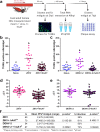Clustered rapid induction of apoptosis limits ZIKV and DENV-2 proliferation in the midguts of Aedes aegypti
- PMID: 33452408
- PMCID: PMC7810730
- DOI: 10.1038/s42003-020-01614-9
Clustered rapid induction of apoptosis limits ZIKV and DENV-2 proliferation in the midguts of Aedes aegypti
Abstract
Inter-host transmission of pathogenic arboviruses such as dengue virus (DENV) and Zika virus (ZIKV) requires systemic infection of the mosquito vector. Successful systemic infection requires initial viral entry and proliferation in the midgut cells of the mosquito followed by dissemination to secondary tissues and eventual entry into salivary glands1. Lack of arbovirus proliferation in midgut cells has been observed in several Aedes aegypti strains2, but the midgut antiviral responses underlying this phenomenon are not yet fully understood. We report here that there is a rapid induction of apoptosis (RIA) in the Aedes aegypti midgut epithelium within 2 hours of infection with DENV-2 or ZIKV in both in vivo blood-feeding and ex vivo midgut infection models. Inhibition of RIA led to increased virus proliferation in the midgut, implicating RIA as an innate immune mechanism mediating midgut infection in this mosquito vector.
Conflict of interest statement
The authors declare no competing interests.
Figures





Similar articles
-
Zika Virus Dissemination from the Midgut of Aedes aegypti is Facilitated by Bloodmeal-Mediated Structural Modification of the Midgut Basal Lamina.Viruses. 2019 Nov 14;11(11):1056. doi: 10.3390/v11111056. Viruses. 2019. PMID: 31739432 Free PMC article.
-
A high-risk Zika and dengue transmission hub: virus detections in mosquitoes at a Brazilian university campus.Parasit Vectors. 2018 Jun 22;11(1):359. doi: 10.1186/s13071-018-2883-8. Parasit Vectors. 2018. PMID: 29929561 Free PMC article.
-
Distinct Roles of Hemocytes at Different Stages of Infection by Dengue and Zika Viruses in Aedes aegypti Mosquitoes.Front Immunol. 2021 May 13;12:660873. doi: 10.3389/fimmu.2021.660873. eCollection 2021. Front Immunol. 2021. PMID: 34093550 Free PMC article.
-
Dengue and Zika viruses: lessons learned from the similarities between these Aedes mosquito-vectored arboviruses.J Microbiol. 2017 Feb;55(2):81-89. doi: 10.1007/s12275-017-6494-4. Epub 2017 Jan 26. J Microbiol. 2017. PMID: 28120186 Review.
-
A comprehensive review of Wolbachia-mediated mechanisms to control dengue virus transmission in Aedes aegypti through innate immune pathways.Front Immunol. 2024 Aug 8;15:1434003. doi: 10.3389/fimmu.2024.1434003. eCollection 2024. Front Immunol. 2024. PMID: 39176079 Free PMC article. Review.
Cited by
-
Expressing the Pro-Apoptotic Reaper Protein via Insertion into the Structural Open Reading Frame of Sindbis Virus Reduces the Ability to Infect Aedes aegypti Mosquitoes.Viruses. 2022 Sep 13;14(9):2035. doi: 10.3390/v14092035. Viruses. 2022. PMID: 36146841 Free PMC article.
-
Flaviviruses: Innate Immunity, Inflammasome Activation, Inflammatory Cell Death, and Cytokines.Front Immunol. 2022 Jan 28;13:829433. doi: 10.3389/fimmu.2022.829433. eCollection 2022. Front Immunol. 2022. PMID: 35154151 Free PMC article. Review.
-
Evolution of innate immunity: lessons from mammalian models shaping our current view of insect immunity.J Comp Physiol B. 2024 Apr;194(2):105-119. doi: 10.1007/s00360-024-01549-1. Epub 2024 Apr 4. J Comp Physiol B. 2024. PMID: 38573502 Review.
-
Zika virus exists in enterocytes and enteroendocrine cells of the Aedes aegypti midgut.iScience. 2024 Jun 22;27(7):110353. doi: 10.1016/j.isci.2024.110353. eCollection 2024 Jul 19. iScience. 2024. PMID: 39055935 Free PMC article.
-
Immune-related transcripts, microbiota and vector competence differ in dengue-2 virus-infected geographically distinct Aedes aegypti populations.Parasit Vectors. 2023 May 19;16(1):166. doi: 10.1186/s13071-023-05784-3. Parasit Vectors. 2023. PMID: 37208697 Free PMC article.
References
-
- Caicedo PA, et al. Selection of Aedes aegypti (Diptera: Culicidae) strains that are susceptible or refractory to Dengue-2 virus. Can. Entomol. 2013;145:273–282. doi: 10.4039/tce.2012.105. - DOI
Publication types
MeSH terms
Grants and funding
LinkOut - more resources
Full Text Sources
Other Literature Sources
Medical

